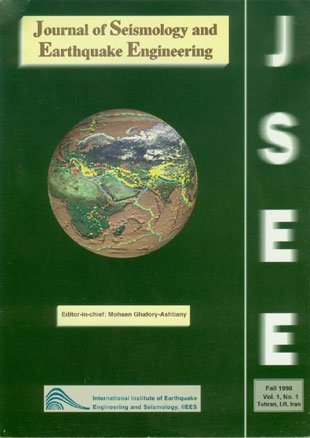فهرست مطالب

Journal of Seismology and Earthquake Engineering
Volume:1 Issue: 1, Autumn 1998
- تاریخ انتشار: 1377/08/11
- تعداد عناوین: 5
-
-
Page 1The Iranian strong motion records are studied and corrected in order to develop a reliable data base for further studies such as seismic hazard assessment. The Iranian strong motion network was installed in 1974, and now comprises 1000 stations under the supervision of BHRC. This instruments are SMA-1 analog (installed before the Manjil Earthquake) and SSA-2 digital kinemetrics types (after Manjil Earthquake). Out of a total of 450 records with a priori satisfactory quality (well recorded and correctly digitized in the case of the SMA-1 records), a set of 279 records was selected for which it was possible to associate correctly determined source parameters (source magnitudes and epicentral distances): 169 correspond to SMA-1 instruments, and the remaining 110 to seismotectonics regions are; 143 in Zagros, 78 in Central-Iran / lut, 48 in Alborz, 9 in Azarbayjan and one record in the Kopeh-Dagh region. The main outcome of this paper is to provide the first strong motion catalogue of Iran, with the indication of the site conditions;the frequency band over which the records are reliable, the peak values of acceleration, velocity and displacements,the source parameters (magnitudes, epicentral and macroseismic distances), the intensity and finally the fault plane solutions whenever possible.
-
Page 35A random vibration approach for the response analysis of linear multi-support structural systems, previously developed by the authors, is briefly reviewed. It werves as the basis for the formulation of a response spectrum method for the seismic response analysis of multiplysupported structures. The response of a two-span beam subjected to spatially-varying earthquake ground motion is analyszed. The influence of uniform and varying local soil conditions. wave passage and incoherence effects on the response of the beam is studied. The significance of each effect is assessed and the relative importance of the pseudo- static and the dynamic response is examined. For comparison purposes, the results also include the cases of statistically independent and perfectly correlated ground motion input.
-
Page 51A type of connection, called Khorjeeni, has been widely used in Iran for low-rise steel frame buildings. The term describes the configuration with two beam profiles placed on the sides of the columns. Here we use the English equivalent and refer to this connection as satchel connection. The beam profiles are fastened to the columns by top and seat angles placed parallel to the beam. Depending on the relative stiffness of the angles, profiles, and the strength of the welds, the connection stiffness may range from very stiff to quite flexible. A large number of steel frames with satchel connections have been used in the earthquake zones, replacing masonry buildings destroyed by previous earthquakes. However, their effectiveness remains unclear under seismic forces. The stress in the connection is due to bending, shear, and torsion. Testraining in-plane forces are developed in the angles as they are typically welded to the flange of the beam profiles. These restrictions increase the bending capacity of the angle substantially, making the connection much stiffer. Excessive drift is often a major problem in flexible connections. Until recently building codes did not allow flexible connections in earthquake or high wind regions. The economic and practical advantages of flexible connections, however, have provided impetus for much research in recent years. Based on this research the Eurocode has already provided specifications for the use of flexible connections and the AISC Code is developing similar specifications. This paper discusses the nonlinear deformations of satchel connections. The purpose of the study is to develop a better understanding of the behavior of this type of connection under monotonic and cyclic loads, and to identify the areas requiring special attention during the design.
-
Page 59In the upcoming years, efforts in the field of earthquake disaster risk assessment and management should foucus on three main issues: (1) urban risk, (2) a holistic, multidisciplinary approach, and (3) the implementation and dissemination of current knowledge. This paper introduces a series of three complementary projects-in risk assessment, risk management, and risk forecasting, and describes how, individually and collectively, they embody a new philosophy built on these three main issues. The first study attempts to assess the relative overall earthquake disaster risk of cities worldwide, and the relative contributions of vatious factors to that risk. The second seeks to compare the cost-effectiveness and feasibility of different risk mitigation strategies for a city. The third aims to forecast how a city''s risk, and therefore the most appropriate mitigation strategies, will change over time.


